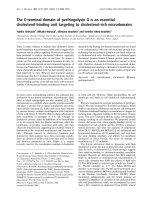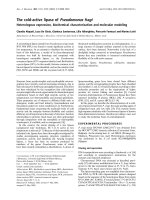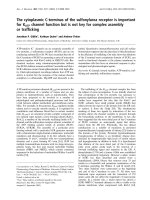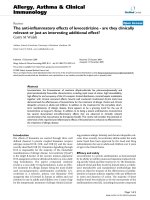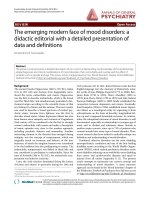Báo cáo y học: "The Hoover''''s Sign of Pulmonary Disease: Molecular Basis and Clinical Relevance" docx
Bạn đang xem bản rút gọn của tài liệu. Xem và tải ngay bản đầy đủ của tài liệu tại đây (917.5 KB, 5 trang )
BioMed Central
Page 1 of 5
(page number not for citation purposes)
Clinical and Molecular Allergy
Open Access
Review
The Hoover's Sign of Pulmonary Disease: Molecular Basis and
Clinical Relevance
Chambless R Johnston III*
1
, Narayanaswamy Krishnaswamy
1
and
Guha Krishnaswamy
1,2
Address:
1
Department of Internal Medicine, Quillen College of Medicine and James. H. Quillen VA Medical Center, Johnson City, TN 37614-0622,
USA and
2
Department of Medicine, Division of Allergy and Clinical Immunology, James. H. Quillen VA Medical Center, Mountain Home, TN
37684, USA
Email: Chambless R Johnston* - ; Narayanaswamy Krishnaswamy - ;
Guha Krishnaswamy -
* Corresponding author
Abstract
In the 1920's, Hoover described a sign that could be considered a marker of severe airway
obstruction. While readily recognizable at the bedside, it may easily be missed on a cursory physical
examination. Hoover's sign refers to the inspiratory retraction of the lower intercostal spaces that
occurs with obstructive airway disease. It results from alteration in dynamics of diaphragmatic
contraction due to hyperinflation, resulting in traction on the rib margins by the flattened
diaphragm. The sign is reported to have a sensitivity of 58% and specificity of 86% for detection of
airway obstruction. Seen in up to 70% of patients with severe obstruction, this sign is associated
with a patient's body mass index, severity of dyspnea and frequency of exacerbations. Hence the
presence of the Hoover's sign may provide valuable prognostic information in patients with airway
obstruction, and can serve to complement other clinical or functional tests. We present a clinical
and molecular review of the Hoover's sign and explain how it could be utilized in the bedside and
emergent management of airway disease.
Introduction
In the 1920's, Hoover described a sign that could be con-
sidered a marker of severe airway obstruction. While read-
ily recognizable at the bedside, it may also as easily be
missed on physical examination. Hoover's sign refers to
the inspiratory retraction of the lower intercostal spaces. It
results from alteration in dynamics of diaphragmatic con-
traction due to hyperinflation, resulting in traction on the
rib margins by the flattened diaphragm. The sign is
reported to have a sensitivity of 58% and specificity of
86% for detection of airway obstruction. Seen in up to
70% of patients with severe obstruction, this sign is often
associated with body mass index, degree of dyspnea and
frequency of exacerbations. Often overlooked, Hoover's
sign may provide valuable prognostic information. When
present, the sign can be used, along with arterial blood
gasses, pulmonary function and other measures summa-
rized in Table 1, as a marker for severity of airway obstruc-
tion, as seen in emphysema, chronic obstructive
pulmonary disease (COPD) or asthma.
Better clinical and bedside prognosticators of airway
obstruction would be helpful as asthma and COPD are
becoming increasingly prevalent in the population [1].
Published: 5 September 2008
Clinical and Molecular Allergy 2008, 6:8 doi:10.1186/1476-7961-6-8
Received: 28 December 2007
Accepted: 5 September 2008
This article is available from: />© 2008 Johnston et al; licensee BioMed Central Ltd.
This is an Open Access article distributed under the terms of the Creative Commons Attribution License ( />),
which permits unrestricted use, distribution, and reproduction in any medium, provided the original work is properly cited.
Clinical and Molecular Allergy 2008, 6:8 />Page 2 of 5
(page number not for citation purposes)
COPD is the fourth leading cause of death in the United
States behind coronary artery disease, malignancy, and
cerebrovascular disease. In 2000, an estimated 10 million
US adults reported physician-diagnosed COPD. Data
from the Third National Health and Nutrition Examina-
tion Survey (NHANES III), however, estimate that among
11 million US adults with evidence of low lung function,
< 40% reported a diagnosis of COPD or asthma, suggest-
ing that COPD is under-diagnosed. Acute exacerbations of
COPD can result in ventilator failure, and patients with
severe COPD or asthma are more prone to developing this
complication. A clinical, quickly identified manifestation
of respiratory failure is the Hoover's sign, which does not
require expensive tests or waiting for radiological or bio-
chemical results (such as arterial blood gases). Moreover,
when patients presents with an acute exacerbation of air-
way disease in the emergency room or in a physician's
office, they are less likely to tolerate laborious radiological
examinations (such as computed tomograms) and pul-
monary function tests (which require intense patient par-
ticipation). It is in this situation that a positive Hoover's
sign, in association with other clinical parameters, blood
gases or peak expiratory flow tests is likely to assist in
patient triage and management in emergency settings. We
present a review of the clinical and molecular/structural
basis of the Hoover's sign and explain how it could be uti-
lized in the bedside and emergent management of severe
airway disease.
Clinical presentation of Hoover's sign
Case Report
Figure 1 demonstrates the chest wall findings in a 65 year
old male long-term smoker who had frequent hospitaliza-
tion for wheezing in spite of oral steroids. The patient's
medications included prednisone (20 mg/day), formot-
erol and lisinopril. Examination revealed a thin, dyspneic
Caucasian male. Pursed lip breathing, bilateral expiratory
wheezing and Hoover's sign were present. Hoover's sign
refers to the paradoxical inspiratory retraction of the rib
cage and lower intercostal interspaces (Figure 1 Panels A
and B). This patient had evidence of moderate airway
obstruction and elevated residual volumes (Figure 1 Pan-
els C and D). There was poor reversibility with bronchodi-
lators. The patient had a low alpha-1 antitrypsin level of
83 mg/dl (N = 90–200 mg/dl) and he was classified as a
MZ phenotype. Figure 2 demonstrates the chest roentgen-
ogram of the patient, with panel A being the postero-ante-
rior and B lateral views of the chest roentgenograms of the
same patient. The arrow marks refer to the flattening of
the diaphragm (white arrows), emphysematous changes
(yellow arrow) and the decreased zone of apposition (red
arrow). The significance of this is discussed under mecha-
nisms below.
What is Hoover's sign?
Originally described in 1920 by Hoover, this eponymous
sign refers to the paradoxical inspiratory indrawing of the
lateral rib margin which has been attributed to direct trac-
tion on the lateral rib margins by the flattened diaphragm
[2,3]. Normally, the costal margin moves very little during
regular breathing, but, if it does, it moves outward and
upward. In patients with obstructive airway disease there
is a higher tendency for it to move paradoxically [4]. In
these patients, paradoxical movements of the sternum as
well as of the abdominal wall may be seen [5]. Garcia-
Pachon et al., found Hoover's sign expression in 62 out of
82 patients with COPD (sensitivity of 76%), 3 out of 23
patients with asthma (13%) and in 3 out of 101 (3%) of
patients with congestive heart failure [6]. In a larger study
of 157 patients, the same investigators demonstrated pres-
ence of Hoover's sign in 71 patients (45% of study popu-
lation), and in 36%, 43% and 76% respectively of patients
with mild, moderate or severe COPD [3]. Garcia-Pachon
also showed that patients with COPD and Hoover's sign
tended to have a higher dyspnea index/score, have higher
hospitalizations or emergency room visits than patients
without the sign [7]. It appears that Hoover's sign may
provide excellent prognostication of severe COPD. In a
multivariate analysis, severity of dyspnea, the patient's
body mass index, numbers of exacerbations historically
and numbers of prescribed drugs were independently
associated with the sign [3].
Table 1: Suggested Indices Of Severity Of Airway Obstruction
Physical findings Pursed lip breathing
Intercostal retraction (Hoover Sign)
Accessory muscle use
Cyanosis
Hoover's sign?
Laboratory Parameters Pulmonary function (FEV
1
and FEV
1
/FVC)
Peak Expiratory Flow Rate
Hypoxemia
Clinical and Molecular Allergy 2008, 6:8 />Page 3 of 5
(page number not for citation purposes)
The Hoover's Sign of Hysterical Paralysis, not to be con-
fused with the sign being discussed, can be found in the
neurological literature that describes a sign to separate
organic from non-organic paresis of the leg. Involuntary
extension of the paralyzed leg occurs when flexing the
contralateral leg against resistance. The patient lies supine,
the examiner's hand is placed under the non-paralyzed
heel, and the patient is asked to elevate the paralyzed leg.
In organic paresis the examiner feels a downward pressure
under the non-paralyzed heel; in malingering no pressure
is felt. This sign is not within the purview of the current
review.
Presumed molecular mechanisms behind Hoover's sign
Studies by Gilmartin and Gibson suggest that transdia-
phragmatic pressures play a major role in the pathogene-
sis of Hoover's sign [8]. Figure 3 demonstrates the
possible mechanism behind Hoover's sign. With emphy-
sema secondary to airway obstruction, flattening of the
diaphragm occurs (as shown also in Figure 2). This leads
to increased radius of curvature, which in turn increases
muscle tension. Secondary to the horizontal orientation
of the diaphragm and the associated loss of the zone of
apposition between the visceral and parietal pleurae (Fig-
ure 3 right panel), the force vector on the lower aspects of
the ribs become inward rather than cephalad. This culmi-
nates in the lower rib cage motion directed inward on
inspiration instead of outward, the paradoxical move-
Hoover's sign refers to the paradoxical inspiratory retraction of the rib cage and lower intercostal interspaces (Figure 1 Pan-els A and B)Figure 1
Hoover's sign refers to the paradoxical inspiratory retraction of the rib cage and lower intercostal interspaces
(Figure 1 Panels A and B). This patient had evidence of moderate airway obstruction and elevated residual volumes (Fig-
ure 1 Panels C and D).
Clinical and Molecular Allergy 2008, 6:8 />Page 4 of 5
(page number not for citation purposes)
ment referred to as Hoover's sign. In an exacerbation, the
presence of mucus and bronchoconstriction further
increases airway resistance, work of breathing and lung
inflation. This leads to more diaphragmatic flattening and
exacerbation of the mechanisms mentioned above. It
would be interesting to study molecular changes in the
musculature such as expression of certain muscle genes
and ultrastructural alterations in muscle but these have
not been done.
Clinical significance of Hoover's sign
Hoover's sign is a frequent finding in COPD, and the fre-
quency increases with severity. The sign can also be
present in patients with congestive heart failure, asthma,
severe pneumonia (especially in children), bronchiolitis,
as well as seen unilaterally in diaphragmatic paralysis,
pleural effusion and pneumothorax.
The Hoover's sign is reported to have a sensitivity of 58%
and specificity of 86% for detection of airway obstruction
in a study by experienced respiratory medicine specialists
among a group of first year residents in family medicine
[9]. The study compared the accuracy of Hoover's sign
detecting obstructive airway disease compared with tradi-
tional signs such as wheezing, rhonchi and/or reduced
breath sounds. Observer agreement in the study (kappa
statistic) was 0.74 for Hoover sign and was lower for the
rest of the signs stated above [9]. The Hoover's sign had a
positive likelihood ratio of 4.16, which was higher than
that of the other signs. Obstructive airway disease in the
study was defined as an FEV1/FVC ratio of < 0.70. There
have been no studies conducted on the sensitivity and
specificity of Hoover's sign in asthma. There is no data
available either on the cost savings that may be induced
by using Hoover's sign as opposed to use of chest roentge-
nography, pulmonary function tests or arterial blood
gases, for example. The duration of persistence of Hoo-
ver's sign, its appearance or disappearance in relationship
to exacerbations and remissions and the influence of
aggressive therapy on extent of retraction are hitherto
unknown. Further studies would certainly improve
insights into the pathogenesis of airway obstruction but
probably would be unlikely to be done in this day and age
of high technology and digital imaging.
Conclusion
Hoover's sign refers to the inspiratory retraction of the
lower intercostal spaces. It results from alteration in
dynamics of diaphragmatic contraction due to hyperinfla-
tion, resulting in traction on the rib margins by the flat-
tened diaphragm. Seen in up to 70% of patients with
severe obstruction, this sign is associated with body mass
index, dyspnea and frequency of exacerbations. This sign
can be an excellent marker for severe airway obstruction.
Competing interests
The authors declare that they have no competing interests.
With A showing PA and B showing lateral views of the chest roentgenograms of the same patientFigure 2
With A showing PA and B showing lateral views of the chest roentgenograms of the same patient. The arrow
marks refer to the flattening of the diaphragm (white arrows), emphysematous changes (yellow arrow) and the decreased zone
of apposition (red arrow).
Clinical and Molecular Allergy 2008, 6:8 />Page 5 of 5
(page number not for citation purposes)
Consent
Written informed consent was obtained from the patient
for publication of this case report and accompanying
images. A copy of the written consent is available for
review by the Editor-in-Chief of this journal.
Authors' contributions
CRJ carried out the research into Hoover's sign, and in
structuring and outline of the manuscript; NK assisted
with the case report and editing process; GK conceived the
study, helped in the editing process, created the graphics
and elaborated the case report.
References
1. Klein M: Hoover sign and peripheral airways obstruction. J
Pediatr 1992, 120:495-496.
2. Hoover CF: The diagnostic significance of inspiratory move-
mens of the rib costal margins. Am J Med Sci 1920, 159:633-646.
3. Garcia-Pachon E, Padilla-Navas I: Frequency of Hoover's sign in
stable patients with chronic obstructive pulmonary disease.
Int J Clin Pract 2006, 60:514-517.
4. Campbell EJM: Physical signs of diffuse airways obstruction and
lung distension. Thorax 1969, 24:1-3.
5. Gilmartin JJ, Gibson GJ: Abnormalities of chest wall motion in
patients with chronic airflow obstruction. Thorax 1984,
39:264-271.
6. Garcia PE, Padilla N I: [Paradoxical costal shift throughout
inspiration (Hoover's sign) in patients admitted because of
dyspnea]. Rev Clin Esp 2005, 205:113-115.
7. Garcia-Pachon E, Padilla-Navas I: Clinical implications of Hoo-
ver's sign in chronic obstructive pulmonary disease. Eur J
Intern Med 2004, 15:50-53.
8. Gilmartin JJ, Gibson GJ: Mechanisms of paradoxical rib cage
motion in patients with chronic obstructive pulmonary dis-
ease. Am Rev Respir Dis 1986, 134:683-687.
9. Garcia-Pachon E: Paradoxical movement of the lateral rib
margin (Hoover sign) for detecting obstructive airway dis-
ease. Chest 2002, 122:651-655.
Demonstrates the mechanism behind Hoover's signFigure 3
Demonstrates the mechanism behind Hoover's sign. The numbers on the figure refer to the following: 1 = accessory
muscles, 2 = hyper-expansion of the lungs, 3 = alteration of rib orientation to horizontal 4 = flattened diaphragm and 5 =
decreased zone of apposition (adapted from Mason: Murray and Nadel's Textbook of Respiratory Medicine, 4
th
Edition).


